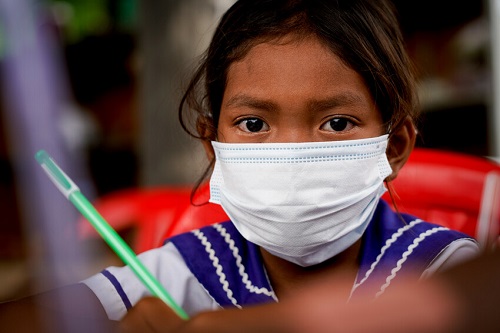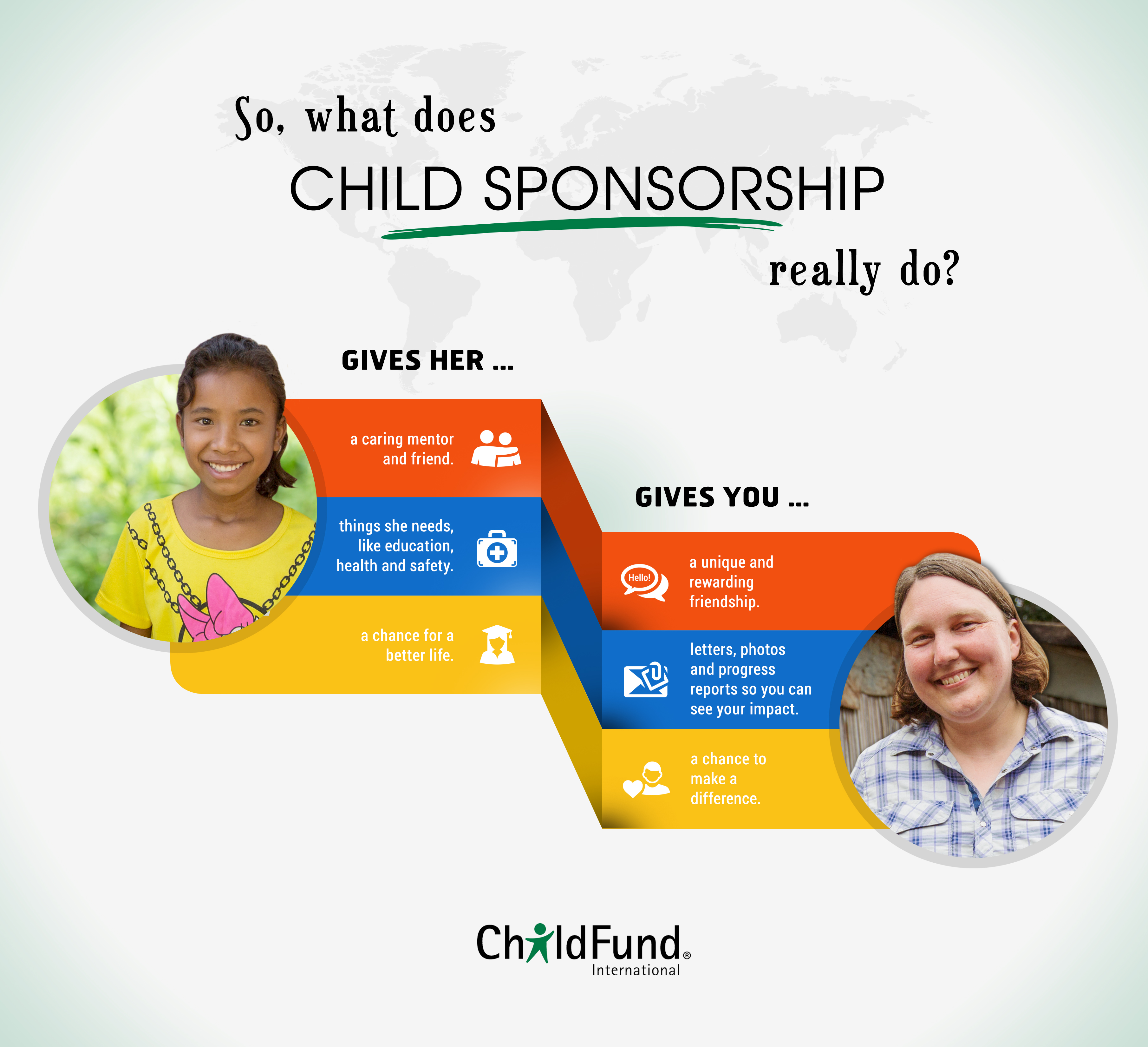Site will be
unavailable for maintenance from June. 4, 11:30 p.m., to June 5, 12:30 a.m. ET. Thank you for your
patience!
Global crisis, global impact: Adapting to serve children during COVID-19

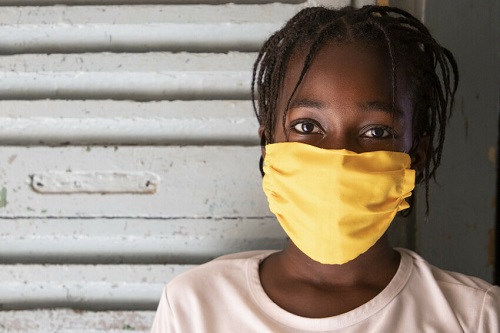
Fatou, 15, was diagnosed with COVID-19 last year in Dakar, Senegal. ChildFund supported her family with a cash transfer of about $100, plus food support and a handwashing station.
Loading...

When the COVID-19 crisis took the world by storm in early 2020, no one could have foreseen the devastation that would follow: not just the lives lost to disease, but also to hunger; not just the havoc wreaked on public health systems, but on local and national economies; not just the terror of actually falling ill, but of being a child in a world where nearly everyone is coming face-to-face with their own mortality.
It is no secret that the effects of COVID-19 on children have been immense, both physically and psychologically. When ChildFund launched our global COVID-19 response plan in April 2020 – the largest in our 80-year history – it was with that thought in mind: How will this crisis derail the development of the children we serve? What harms will this put them at risk for, and what struggles will they and their families have to face to survive an even more extreme version of poverty? Diverting $30 million in funding from our own regular programming between April and December 2020, we developed a four-pronged approach for helping children during COVID-19 that has, to date, reached millions of kids and families in 61 countries with lifesaving aid. Here’s how we pulled it off.
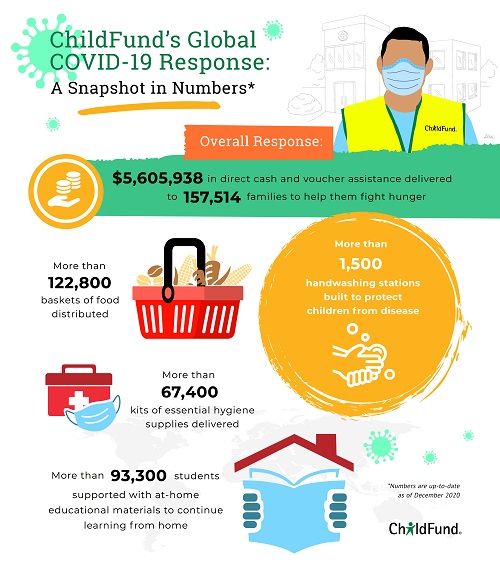
Stopping the Spread of COVID-19
In a battle with a deadly virus, the first and most important weapon is accurate information – something that’s not always easy to come by when you live in a remote community miles away from the nearest town. Our local partner organizations around the world got to work spreading public health messages about the virus and its prevention in the communities we serve, using any means necessary – flyers, radio, community awareness sessions. Children themselves often helped us get the word out about social distancing, wearing masks and, of course, handwashing.
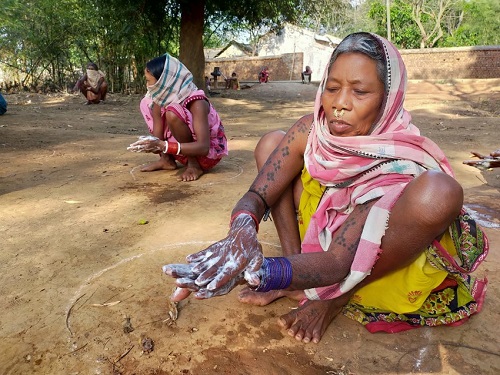
Family members in India learn about proper handwashing during a socially distant community awareness session on COVID-19 prevention.
In many of the areas where we work, however, access even to clean water is a challenge, to say nothing of access to hygiene items like soap, hand sanitizer and masks. We built more than 15,000 handwashing stations in homes and at centrally located areas in communities to make it easier for children and families to wash their hands, and we delivered more than 67,400 hygiene kits with items like soap, gloves and masks to both families and frontline health workers. Van, 12, who lives in rural Vietnam, still remembers how that felt. “My family didn’t have any means of preventing the spread of the disease until ChildFund stepped in to help us,” she says.
Ensuring Children's Access to Food
One of the most critical effects of COVID-19 on children and families was the unwelcome arrival, almost overnight, of hunger. As lockdowns prevented parents from going to work, families were forced to rely on the kindness of neighbors and friends to keep food on the table. To ensure children’s access to regular meals during the pandemic, ChildFund launched a direct cash assistance program that has since helped more than 157,514 families buy food, pay rent or take care of whatever their family’s most urgent needs might be.
The direct cash payments represented a major shift in our usual way of working. ChildFund typically combats hunger and malnutrition in communities by helping families plant vegetable gardens, implementing supplementary feeding programs, and other hands-on initiatives. Given the enormous scale of the crisis and the urgency of children’s needs, wiring cash payments directly to families allowed us to be more agile in our response, conserve resources and reach as many people in need as possible – like Esnart.
At 14 years old, Esnart, who lives in Zambia, is the sole breadwinner of her family. She and her little sister, Grace, 9, lost both their parents years ago, and none of their extended family members would take the girls in. Esnart began doing odd jobs after school to make a little money: selling bananas, harvesting other people’s crops. But then the COVID-19 crisis hit.
“From the time the new disease came, it was difficult to find any jobs,” she says. “Sometimes we would go to bed hungry. Other times, neighbors gave us some food.”
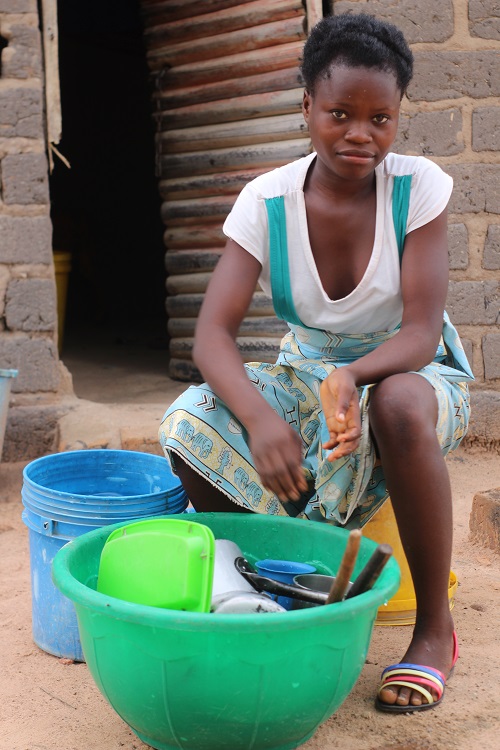
Esnart, 14, in front of the home she shares with her little sister.
Learning she was going to be a recipient of ChildFund’s cash assistance program was the good news she needed to keep going during the worst of the pandemic. “It’s like we now have parents that provide for us,” she says of ChildFund. “I used the first payment to buy food, uniforms, books and other school supplies. I even got some plates, which we didn’t have before.”
Keeping Children Safe from Violence
When the pandemic broke out, global experts feared an uptick in cases of violence against children. Financial instability, stress and the loss of parents and other caregivers to disease have driven rates of harmful practices like child marriage and the online sexual exploitation of children sky-high. To protect the children we serve from violence of all kinds, ChildFund set out to drive home messages promoting their safety and well-being to the most important social structures in a child’s life – their families, and their communities. In Guatemala, for instance, faced with the challenge of reaching families amid strict travel restrictions, we quickly innovated to produce and distribute a radio broadcast for parents on how to maintain loving, positive relationships with their children during COVID-19 and the stresses of lockdown.
For the last several years, ChildFund has invested heavily in creating and strengthening child protection committees. These committees are not unlike what we call child protective services here in the United States; they provide their communities with a way to identify, report and address cases of abuse and other violence against children. Even with travel restrictions in place, child protection committees continued to work in small groups to ensure children’s safety – and children themselves often led the process. For example, in India’s Firozabad district, members of the child protection committees trained children and youth as local reporters to safely document stories about child protection issues during COVID-19. “Ever since I became a child reporter, I started talking openly,” Sonal, a 9th-grader, says. “Earlier I was very afraid to talk to anyone, and now I can take initiative to solve the problems of myself and my community. My self-confidence has increased, and now I can make decisions on my own.”
Helping Children Continue Learning
As schools shut down and children were forced into lockdown at home, access to education became a major concern for kids around the world. In developed countries, this precipitated a shift to widespread virtual learning; in developing countries, however, where large numbers of kids don’t have access to the internet or digital devices, this was often impossible.
ChildFund helped close the learning gap by distributing educational materials to more than 93,300 students that would help them continue their education from home. This included not just traditional books and worksheets, but also digital devices like tablets. The direct cash assistance program also allowed many families to buy digital devices for their children – and school supplies like uniforms and shoes when it was finally time to go back.
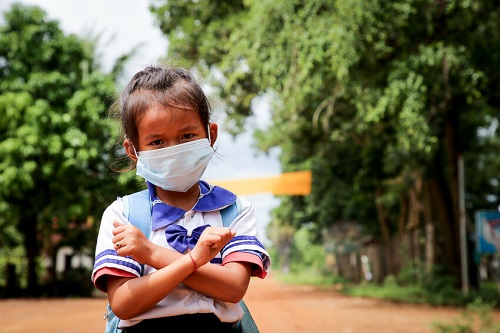
Khema, 6, returns to school in Cambodia.
In countries like Kenya, where the government provided classes via radio, ChildFund also distributed solar-powered radios with reading lights to keep children – like Marion, 15 – connected to their schoolwork. “My siblings and I are now able to listen to radio lessons and study at night,” Marion says – a game-changer for them.
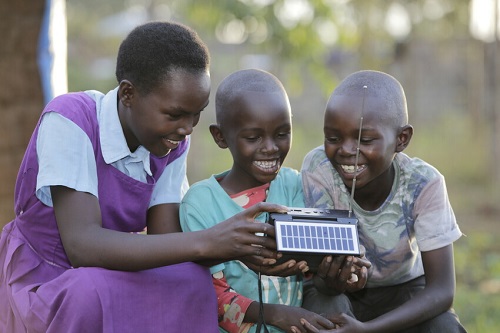
Marion, 15 (left), and her younger siblings listen to school lessons on the solar-powered radio provided by ChildFund.
Adapting Virtually During COVID-19
All of ChildFund’s response efforts have required the ability to adapt quickly and innovate to find new solutions. In March 2020, when our staff all around the world began to work from home, we relied heavily on technology to stay connected to each other and to the children we serve. We hosted webinars and live social media events to educate families about online safety and to keep our supporters up-to-date on our COVID-19 response work. In Bolivia, when a strict lockdown shut down ChildFund’s youth groups, the youth used video conferencing to continue meeting anyway, translating information on COVID-19 prevention into several different languages to make it available for use in their communities. Teens in our programs in the Philippines even used technology to create and broadcast their own vlog on COVID-19 prevention. In October, ChildFund was proud to win a Zoom Innovation Award for forging meaningful virtual connections like these in the midst of the pandemic.
Today, many countries are cautiously emerging from lockdown. Parents are beginning to return to work, and children to school. Even so, the nightmare is far from over for kids living in extreme poverty. The struggle for nutritious food, basic education and protection from violence continues, and other emergencies on top of COVID-19 often uproot whatever semblance of stability they find. The physical and psychological toll that the pandemic has taken on children’s potential, their access to better opportunities in life, cannot be overstated. Indeed, even as COVID-19 restrictions begin to loosen their grip on the world, new variants are constantly emerging, each with its own inherent risks. The lingering effects of the disease on children will be felt for generations to come.
Only when we come together to support these children can we make a tangible difference in their lives. In fact, the global COVID-19 response you just read about has only been made possible by the incredible support we received from our donors – especially the regular monthly contributions that fuel everything we do. When a lot of ordinary people give a little bit, extraordinary things can happen for kids and their families on a global scale. And when we are willing to collectively adapt, we can truly be there for children in their most urgent time of need.
Learn more about our COVID-19 and other humanitarian response efforts in ChildFund's latest Impact Report.
